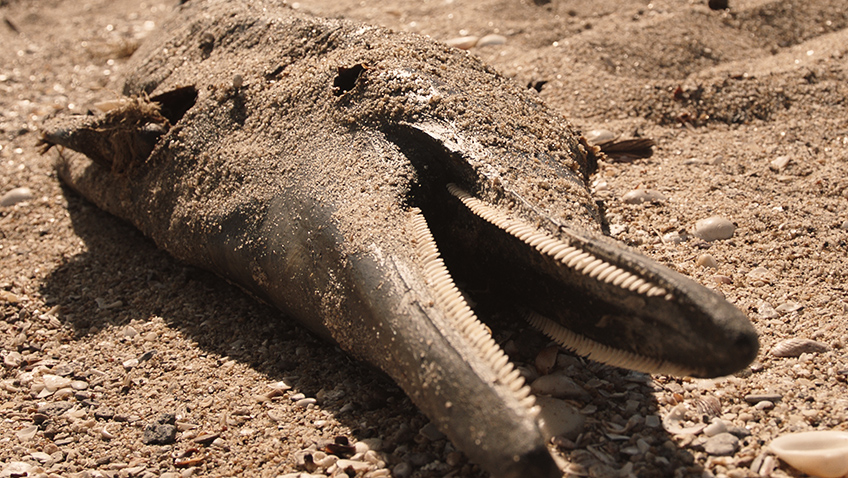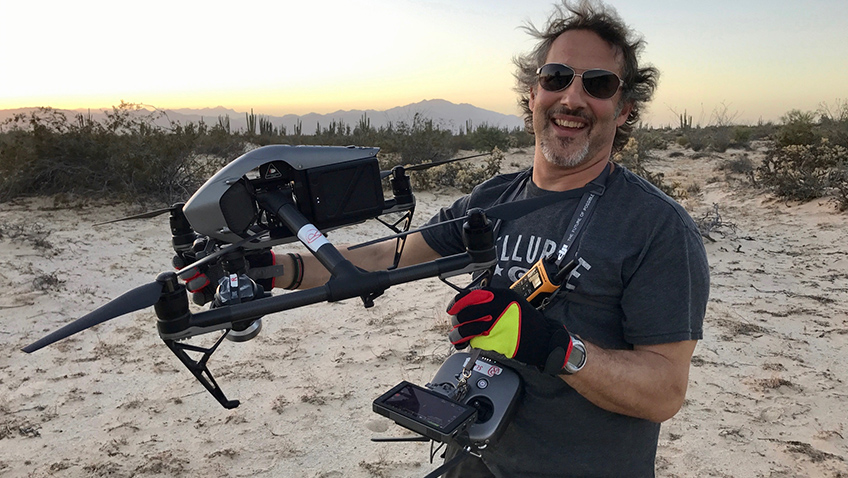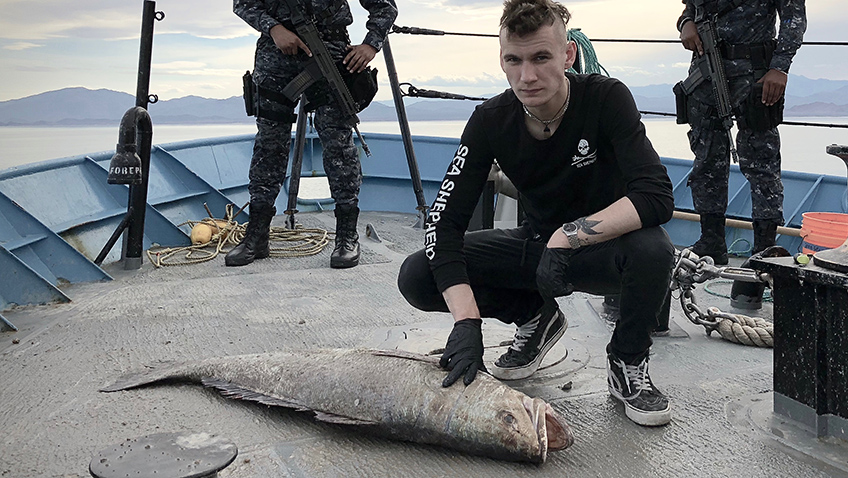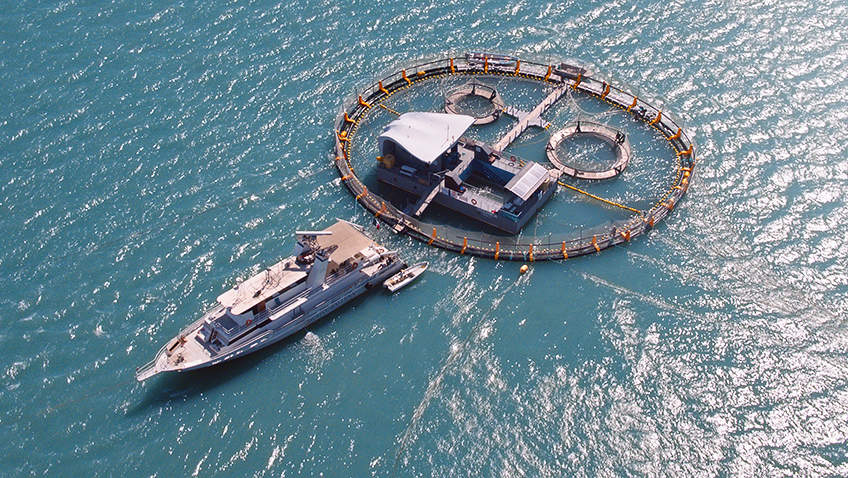Joyce Glasser reviews Sea of Shadows (September 27, 2019), Cert. 12A, 105 min.
We all know that the lungs of the world, the once perfect ecosystem known as the Amazon Jungle is burning, even if world leaders have done, or can do, little to stop it. But it is not widely known that some 6,000 kilometres north, in what Jacques Cousteau called “the aquarium of the planet”, The Sea of Cortez, is a battleground for the survival of this unique ecosystem, and for the last 30 vaquita whales in the world who can exist only in this habitat. Director-cinematographer Richard Ladkani turns the various threads of this complex subject into a riveting investigation into the Mexican cartels and Chinese mafia behind this black market, a story as dramatic as any crime thriller on the market this year.
 The vaquita, whose size makes it closer to a porpoise than to a whale, is an almost Disneyesque mammal with big endearing round eyes and a mouth that forms what looks like a permanent smile. It co-exists with another endangered species, the Totoaba fish, in the unique marine life of the Sea of Cortez. Its fate is intertwined, too literally, with the totoaba, in the illegal nets that local fishermen, well paid by a Mexican cartel, spread across the sea to ensnare the fish.
The vaquita, whose size makes it closer to a porpoise than to a whale, is an almost Disneyesque mammal with big endearing round eyes and a mouth that forms what looks like a permanent smile. It co-exists with another endangered species, the Totoaba fish, in the unique marine life of the Sea of Cortez. Its fate is intertwined, too literally, with the totoaba, in the illegal nets that local fishermen, well paid by a Mexican cartel, spread across the sea to ensnare the fish.
The totoaba swim bladders are more valuable than gold to the Mexican traders and the Chinese traffickers from Guangzhou due to a groundless belief in the medicinal properties of these delicacies. The nets ensnare not only the totoaba and the vaquita, the population of which, during the investigation, falls to an estimated 15 or fewer, but all manner of sea life, including huge turtles.
Ladkani turns up some villains, and their short-sighted pawns, the local fishermen who are destroying their children’s future, and are brain washed into believing that the vaquita is a myth to keep them from making good money from the totoaba net fishing. Fortunately, Ladkani introduces us to some new heroes, too, including father and son team, Javier and Alan Valverde, honest fisherman who help the Sea Shepherd destroy the nets (each net worth $3,000) every night, but who are being chased further south to earn their livelihood as a result.
Chief among the heroes is the popular Televisa (part of Mexico’s ubiquitous privately owned media empire) television news presenter Carlos Loret de Mola, whose programme, ‘Wake up with Loret’, serves a clever and convenient narrative function in the film, anchoring it, so to speak and holding the various threads of the vaquita crisis, together.
For as well as the investigations into the cartels and government corruption, Loret de Mola informs his public of a new international initiative, led by Dr Cynthia Smith, to capture the remaining vaquitas and hold them in large, floating pens in the Sea of Cortez, until it is safe for them to return to the wild. It is an act of desperation for not only are the vaquita – which have never been filmed – difficult to spot and capture, but scientists do not know if they can survive in human care.
Loret de Mola begins by informing his Mexican (and South American) audiences of the background of the conflict, and then provides regular updates that summarise, the following morning, what we have been witnessing behind the scenes. This includes the nightly activities of the Sea Shepherd and its courageous crew, led by Jack Hutton. They risk their lives every night, using cameras on drones to detect the fishermen and alert the generally useless marines so that they can arrest them. The crew also pull up nets and return to the sea any living fish or mammals they find.
As informants admit, everyone in San Felipé is paid off by a man named Oscar Parra who heads the totoaba cartel and is very rich. An informant known as JT, who is pixelated, and his voice disguised, is the first to identify the name of the Mexican behind the illicit trade, Oscar Parra, but not the first to be assassinated by him.
The first (that we are made aware of) is a soldier shot in cold blood by Parra near the San Felipé harbour, a revenge attack perhaps for the marines, alerted by Sea Shepherd, having intervened to chase a “panga” boat into the shallows, aborting their mission. This assassination was, fortunately, caught on camera and Loret de Mola’s colleague Ana Lucía Hernández Sánchez turns the story into a damning video report that runs on air, defying the government to ignore it. (When Parra is finally captured, it is for murder, and not for the swim bladder trafficking).
Loret de Mola also invites government officials, including the dodgy Admiral Romel Eduardo Ledezma Abaroa, on his show to keep the pressure on them, and as part of a strategic ploy to extract promises from them on air.
But when in a tense show-down that Ladkani captures, angry fishermen over-power the cowardly military police who subsequently release three arrested illegal fishermen, Loret de Mola and Andrea Crosta despair of the situation. “The law enforcement in Mexico is so screwed up, I’m not sure how much they’d be willing to do. So, let’s attack them with the power of the media.”
For this purpose, Loret de Mola invites the intrepid Crosta, who battled with elephant poachers in Ladkani’s The Ivory Game, onto the programme to talk about his revealing investigation with Marc Davis (an ex-FBI Special Agent) and undercover agent Oona Layolle, all members of The Earth League International (ELI).
It is ELI that, through its use of informants and undercover tactics, track down and meet with a certain David Lee, obtaining more information – captured on a hidden camera – than they bargained for. “We smuggle it to China by air with a suitcase or carry-on. We bribe customs on all levels. We don’t take the direct Tijuana to Shanghai flights, Customs in Shanghai are too risky.” They fly to Hong Kong and then on to China. Vivid footage of the traffickers’ warehouses, stuffed with small packages, each containing a swim bladder (worth up to $100,000), are also presented in the report that is aired and sent to the Chinese and Mexican authorities that, this time, seem to be taking action.
The film, distributed and financed by National Geographic, looks gorgeous, the clear, blue seas belying the evil that, but for a few good men and women, will destroy it.
You can watch the film trailer here:







